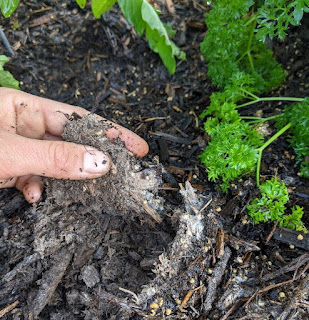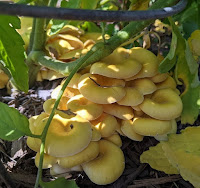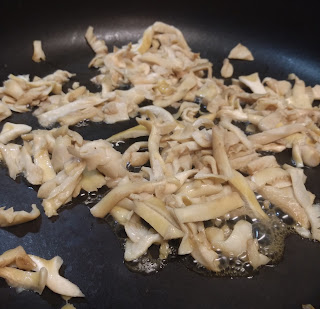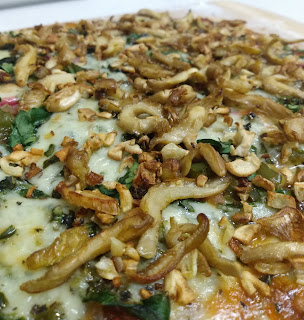
Have you seen the beautiful golden oyster mushrooms growing in the Cromaine vegetable garden? These gourmet mushrooms are often found in local forests, but can also be cultivated in buckets, containers, or right in the soil with your vegetables or flowers! We are so excited to learn about fungi with you as we grow mushrooms in our garden. Be sure to check them out next time you visit the Library, and learn more about growing, sustainably harvesting, and cooking oyster mushrooms below!
The golden oyster mushroom, or Pleurotus citrinopileatus, is an edible gilled fungus in the tree fungi family, Pleurotaceae. Tree mushrooms are decay fungi, which means that they tend to obtain food from decaying wood. Golden oysters have a wonderful earthy, nutty flavor, and make a great contribution to many meals. Inspired by forest symbiosis between plants and fungi, Cromaine staff decided to try growing oyster mushrooms in our vegetable garden!
We purchased our mushroom growing kit from North Spore. They are a mushroom grow kit business featuring a variety of mushrooms to choose from, which can vary in difficulty level, as well as various ways to grow the mushrooms! North Spore also features lots of growing information and tips and tricks to help you make the most of your mushroom kit. If you plan to cultivate your own fungus, take a look through their many options to decide which growing method is right for you. We chose golden oyster mushrooms for their fast growth and bright color, which we hoped would inspire some great learning opportunities with our patrons of all ages. We purchased the Golden Oyster Grain Spawn, which is a bag containing barley grain that has been inoculated with mushroom spawn. The mushroom grows on the grain, which can then be gently broken up and spread with a substrate in order to fruit.

Golden oyster mushrooms work best with substrates such as sawdust, straw, or hardwood mulch-- we purchased some beautiful hardwood mulch from our local friends at Giegler's Feed and Seed for our project! We mixed our spawn bag with the hardwood mulch and spread the mulch over our vegetable garden, making sure to put lots of it in especially shady areas of the garden bed, like beneath the kale and tomato plants. Then, we added a little more hardwood mulch on top and watered it. Over the following weeks, we watered the mulch along with the garden vegetables and waited for the magic to happen!
*Please note that cedar mulch will not promote fungal growth, as cedar is naturally anti-fungal!*
After a few weeks, the mycelial network began to grow in the soil and spread around the mulch, forming a mat of fungus that could be seen just below the soil. The mycelium is a white substance that almost looks like cotton, and is an indicator that the fungus is alive and growing!

After only about three weeks, the mycelium was healthy enough to fruit. Tiny mushrooms popped from the mulch, and within a few days we had oyster mushrooms all over the garden bed!


Fungi are not known to compete with plants for resources, and in fact can even form a symbiotic relationship with your garden plants. According to North Spore, "a major function of decomposer fungi like Wine Cap or Oyster mushrooms is cycling organic matter back into the soil. Through decomposition, they break down complex organic molecules into simpler forms that are easier to access by plants. This process helps create long-term storage of nutrients. More organic matter also means greater water holding capacity, porosity (important for clay-heavy soils), and soil structure or tilth." Those are some serious garden benefits!

To harvest oyster mushrooms, carefully twist and pull the cluster near the base, or cut them as close to the soil as possible with a knife. Oysters tend to be pretty prolific, but it's still best to harvest sustainably by taking some, but not all, of the mushrooms at once from one location. If you plan to eat wild grown mushrooms, please remember that all bodies are different and that some of us respond differently to consuming these mushrooms than others. If you're new to wild mushrooms, it may be best to try a small sample of thoroughly cooked mushroom before enjoying a large portion of it. Also, never eat a wild mushroom unless you are one hundred percent sure of it's identity!
When cleaning and preparing mushrooms, its important to remember that mushrooms are very porous, like a sponge. There are many ways to prepare mushrooms, so feel free to explore the many methods available! The most important thing to remember with any mushroom is to cook them thoroughly.
To remove bugs and dirt, oyster mushrooms can be cleaned with a soft brush or soaked in slightly salty water for a few minutes. If you decide to soak the mushrooms, be careful not to soak them for too long, as they can lose their wonderful texture if oversoaked. They can be dried, gill-side down, on paper towel or cloth for about ten minutes, and when they are sufficiently dry, I recommend throwing them on the frying pan dry-- with no butter or oil. As they cook, they will release their moisture into the pan to cook off. Once this happens and most or all of the moisture is removed from the mushrooms (about ten minutes), you can add butter, dressing, or any other cooking agent you like for the mushrooms to soak up!

I sliced my mushrooms and cooked them in butter after cooking off their internal moisture. This helps to keep that wonderful meaty, firm texture!

I cooked my mushrooms for another ten minutes or so in butter, then topped a homemade pizza with them and baked. It was one of the best pizzas I've ever had! Learn more about cooking with mushrooms, and get some fantastic recipes, here.
Be sure to check the Library vegetable garden for some lovely golden oyster mushrooms! We are so excited to learn more about the relationship between fungi and plants, and the wonderful world of mushrooms, throughout the summer and into autumn. To learn more about mushrooms, visit our program recap blog post Foraging, Cooking, and Gardening Edible Mushrooms from the Michigan Mushroom Hunters, and be sure to check out the Kanopy film Mushrooms: A Superfood for Well-Being. And don't forget to take a look in the vegetable garden to see if you can spot some golden oyster mushrooms!